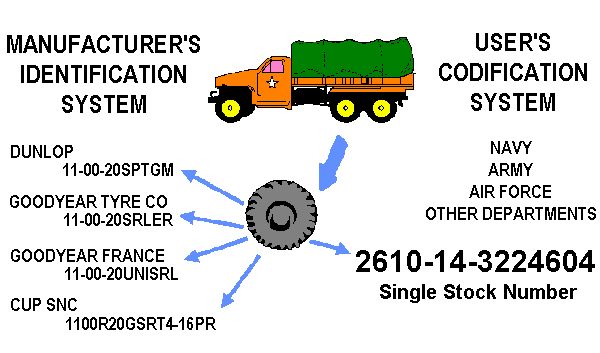NATO Stock Number (NSN)
General
Countries that participate in the NATO Codification System (NCS) follow
common standards and techniques to assign NATO Stock Numbers (NSN) to items of
supply in their defense inventory. The National Codification Bureau (NCB) within
each country centrally assigns their national NSNs. The assignment of an NSN
fixes the identity of each distinctive item of supply. All NSNs are uniform in
composition, length, and structure. Each is represented by a 13-digit number,
which can be divided into three unique parts as follows:
-
the first four digits are the NATO Supply Classification (NSC) code, which
relates the item to the group and class of similar items
-
the next two digits indicate the assigning NCB code (each country has its
own two-digit NCB code. For example, the United States uses "00" and
"01")
-
the final seven digits are assigned sequentially and have no inherent
significance. However, this number relates to one and only one item of
supply within the codifying country.

Within NATO, the NCS currently contains 15 million active NSNs (about 7
million U.S. and about 8 million assigned by other NATO countries). The items
represented range from hand grenades to guided missiles, from propeller blades
to space vehicles, and from soap dishes to washing machines.
The following rules apply to a NSN:
-
The implementation of the NSN have merged the last two parts (NCB code and
final seven digits) into the NATO Item Identification Number (NIIN).
-
The NIIN must be unique in itself (making sure that the NSN is unique
worldwide).
-
When a NSN is saved, the values of the NSC code and the NIIN is
concatenated into the NSN.
-
When a NSN is changed, by changing either NSC and/or NIIN, the change is
tracked in a separate history object.
Connect a part to a NSN
It is possible to connect the parts in IFS/Part Catalog to a NSN. The following rules
are applied in connecting parts to a NSN:
- One NSN can be connected to several part numbers.
- One part number can only be connected to one NSN.
- If several parts are connected to one NSN, only one of the parts can be
the preferred part of the NSN.
- If only one part is connected to one NSN, this part is automatically the
preferred part of the NSN.
Special rules apply to parts connected to NSN if the part is also a Sales
Part:
- If the sales part (inventory) is connected to an inventory part having a
different part number, it is required that the different part numbers are
connected to the same NSN.
- If the non-inventory sales part is connected to a purchase part having a
different part number, it is required that the different part numbers are
connected to the same NSN.

